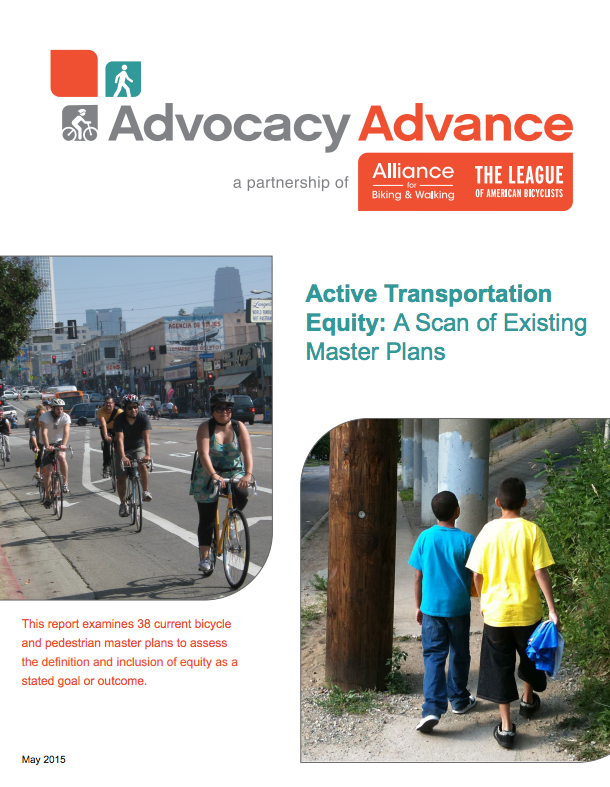DISCOVER YOUR LOCAL BICYCLING COMMUNITY
Find local advocacy groups, bike shops, instructors, clubs, classes and more!
Report: Equity Scan in Master Plans
 This post originally appeared on the Advocacy Advance blog, and it is written by Naomi Doerner, Advocacy & Membership Manager for the Alliance for Biking & Walking.
This post originally appeared on the Advocacy Advance blog, and it is written by Naomi Doerner, Advocacy & Membership Manager for the Alliance for Biking & Walking.
Last week, Advocacy Advance released a new resource, “Active Transportation Equity: A Scan of Existing Master Plans.” While the report is not a comprehensive list, it cites 38 examples of active transportation master plans that include definitions of equity, equity goals, and — in some cases — performance measures for equity.
But why this equity resource? What’s its purpose?
Great questions — and you aren’t alone in asking them. Along with our reviewers, I also reflected on the scope and purpose of this report — and what was missing. But first a little more context about the report’s goal.
In November 2014, Advocacy Advance awarded the Los Angeles County Bicycle Coalition (LACBC) a Big Ideas grant. The funding supports LACBC’s bold vision to work in partnership with local planners to create “an inclusive and equitable active transportation master planning process” that would boost funding opportunities for walking and bicycling projects in five cities in southeastern Los Angeles County. LACBC sought examples of community engagement processes that have led to equitable walking and bicycling master plans.
Based on our work to support LACBC, coupled with growing interest from advocates, partners, and researchers for equity-based resources — Advocacy Advance documented its initial research findings so advocates engaged in planning processes can consider how equity has been incorporated by others.
It was a meta exercise in which we reviewed 38 planning documents. It’s important to remember that the documents themselves are the result of local processes that gathered and incorporated community data and input. Our work was simply (and literally) a scan: we searched for the word “equity” to see how different communities defined and used it in their active transportation planning process.

But here’s where more questions arose. When the scan was completed, I still wondered if this report would be helpful for advocates, planners, and agency staff.
As a transportation planner-turned-advocate, I know final planning documents tend to be slick and glossy. But there’s a critical engagement piece that informs that deliverable, and it’s comprised of stakeholders that can’t be packaged up with a bow. It’s their input that determines the plan and that plans’ long-term outcomes. So knowing who the stakeholders are (and aren’t) in a planning process is critical to understanding the plan itself. What is their stake? Do they co-define equity and goals associated with addressing inequity? Do they have and share decision-making power?
The report doesn’t answer the who question, nor did it intend to. It doesn’t provide a historical backdrop offering context for why social and racial justice and equity matter in the context of urban and active transportation planning, particularly in the wake of the protests in Ferguson and most recently in Baltimore. That wasn’t the scan’s intent, either. And it’s important to remember that it doesn’t list 38 best practices; it simply lists 38 planning documents that incorporate equity on various levels.
For me, the most significant impact of this report is that it provokes important questions — questions that required me to reflect deeply upon what equity means, how inclusion is fostered, and ways in which a diversity of experiences and perspectives or a lack thereof within our organizations, communities, and institutions impact decisions. In this way, I hope others find the scan as useful as I did, as a jumping off point for analyzing local planning processes.
Advocacy Advance will provide follow-up to the active transportation scan that will include a select number of stakeholder interviews from some of the plans listed in this initial document. This will shed more light on what worked or what didn’t work, which many of you may also find useful.
What questions do you have? Are there other kinds of equity-based resources that would assist your organization and work? If so, what are they? Feel free to email me directly at[email protected], or contact the report’s primary author, Ken McLeod, the League’s Legal & Policy Specialist, [email protected].
Also join us for a Twitter chat about the report next Friday, May 29, at 2 p.m. ET, hosted by the League (@bikeleague). Use hashtag #BikeChat to follow along and chime in with your own questions!